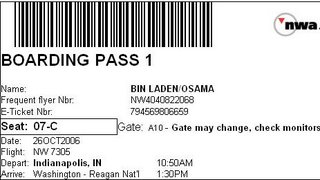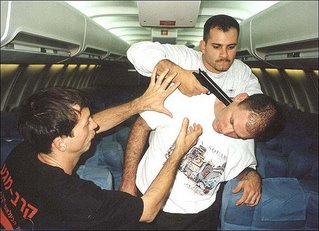Thursday, November 02, 2006
Security shmecurity
Wired Magazine has an interesting article about aviation security and the «fake boarding pass brouhaha» (http://tinyurl.com/yk4xxn) by Bruce Schneier (www.schneier.com). Here are some excerpts.
«Last week Christopher Soghoian created a Fake Boarding Pass Generator website, allowing anyone to create a fake Northwest Airlines boarding pass: any name, airport, date, flight. This action got him visited by the FBI, who later came back, smashed open his front door, and seized his computers and other belongings. It resulted in calls for his arrest [...] And it's gotten him more publicity than he ever dreamed of. All for demonstrating a known and obvious vulnerability in airport security involving boarding passes and IDs.
This vulnerability is nothing new.[...] It's kind of obvious, really. If you can make a fake boarding pass, you can get through airport security with it. [...] You can also use a fake boarding pass to fly on someone else's ticket. The trick is to have two boarding passes: one legitimate, in the name the reservation is under, and another phony one that matches the name on your photo ID. Use the fake boarding pass in your name to get through airport security, and the real ticket in someone else's name to board the plane.
This means that a terrorist on the no-fly list can get on a plane: He buys a ticket in someone else's name, perhaps using a stolen credit card, and uses his own photo ID and a fake ticket to get through airport security. Since the ticket is in an innocent's name, it won't raise a flag on the no-fly list. You can also use a fake boarding pass instead of your real one if you have the "SSSS" mark and want to avoid secondary screening, or if you don't have a ticket but want to get into the gate area.
Historically, forging a boarding pass was difficult. It required special paper and equipment. But since Alaska Airlines started the trend in 1999, most airlines now allow you to print your boarding pass using your home computer and bring it with you to the airport. This program was temporarily suspended after 9/11, but was quickly brought back because of pressure from the airlines. People who print the boarding passes at home can go directly to airport security, and that means fewer airline agents are required. [...]
As [Schneier] wrote in 2005: "The vulnerability is obvious, but the general concepts are subtle. There are three things to authenticate: the identity of the traveler, the boarding pass and the computer record. Think of them as three points on the triangle. Under the current system, the boarding pass is compared to the traveler's identity document, and then the boarding pass is compared with the computer record. But because the identity document is never compared with the computer record -- the third leg of the triangle -- it's possible to create two different boarding passes and have no one notice. That's why the attack works."
The way to fix it is equally obvious: Verify the accuracy of the boarding passes at the security checkpoints. If passengers had to scan their boarding passes as they went through screening, the computer could verify that the boarding pass already matched to the photo ID also matched the data in the computer. Close the authentication triangle and the vulnerability disappears.
But before we start spending time and money and Transportation Security Administration agents, let's be honest with ourselves: The photo ID requirement is no more than security theater. Its only security purpose is to check names against the no-fly list, which would still be a joke even if it weren't so easy to circumvent. Identification is not a useful security measure here. [...]
Interestingly enough, while the photo ID requirement is presented as an antiterrorism security measure, it is really an airline-business security measure. It was first implemented after the explosion of TWA Flight 800 over the Atlantic in 1996. The government originally thought a terrorist bomb was responsible, but the explosion was later shown to be an accident.
Unlike every other airplane security measure -- including reinforcing cockpit doors, which could have prevented 9/11 -- the airlines didn't resist this one, because it solved a business problem: the resale of non-refundable tickets. Before the photo ID requirement, these tickets were regularly advertised in classified pages: "Round trip, New York to Los Angeles, 11/21-30, male, $100." Since the airlines never checked IDs, anyone of the correct gender could use the ticket. Airlines hated that, and tried repeatedly to shut that market down. In 1996, the airlines were finally able to solve that problem and blame it on the FAA and terrorism.»
Subscribe to:
Post Comments (Atom)







2 comments:
Me i like to take the plane
Thanks for sharing the information and keep sharing the blogs.Fake Boarding Pass Generator
Post a Comment